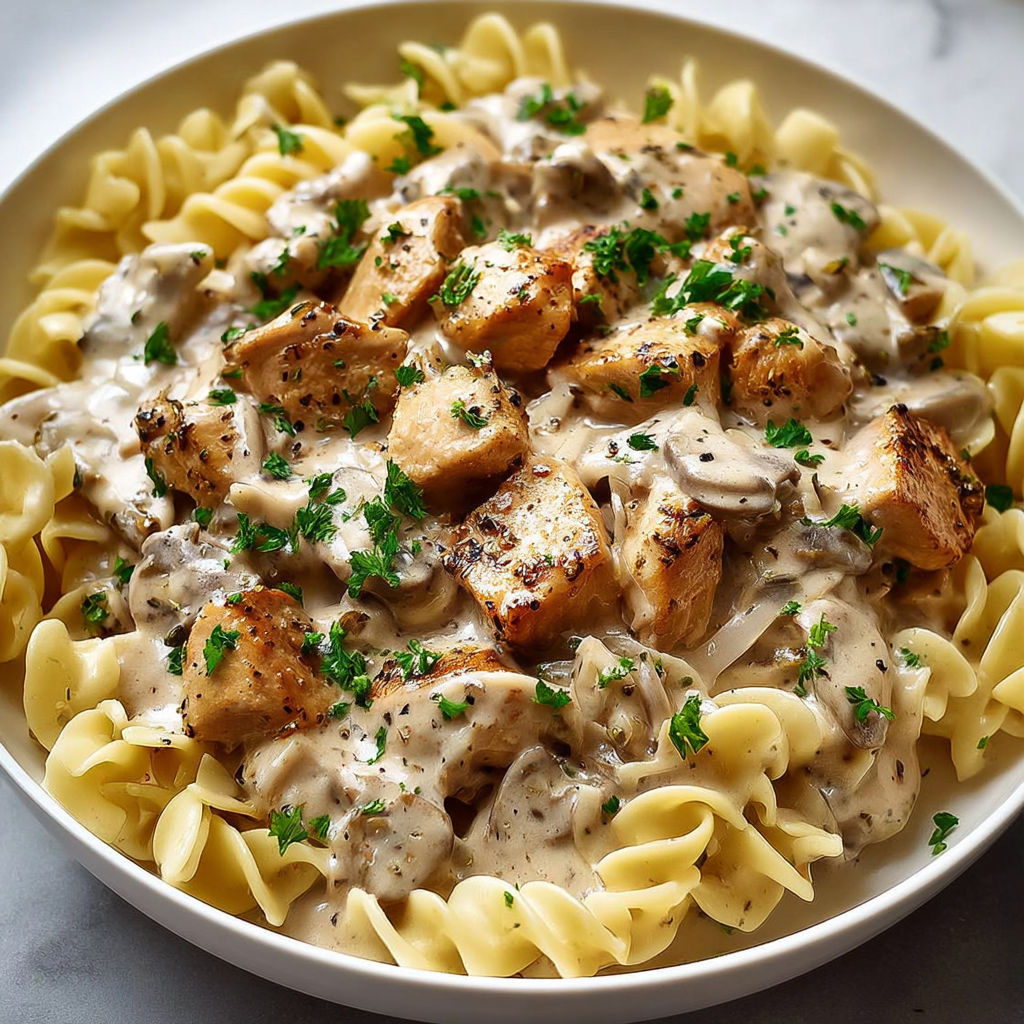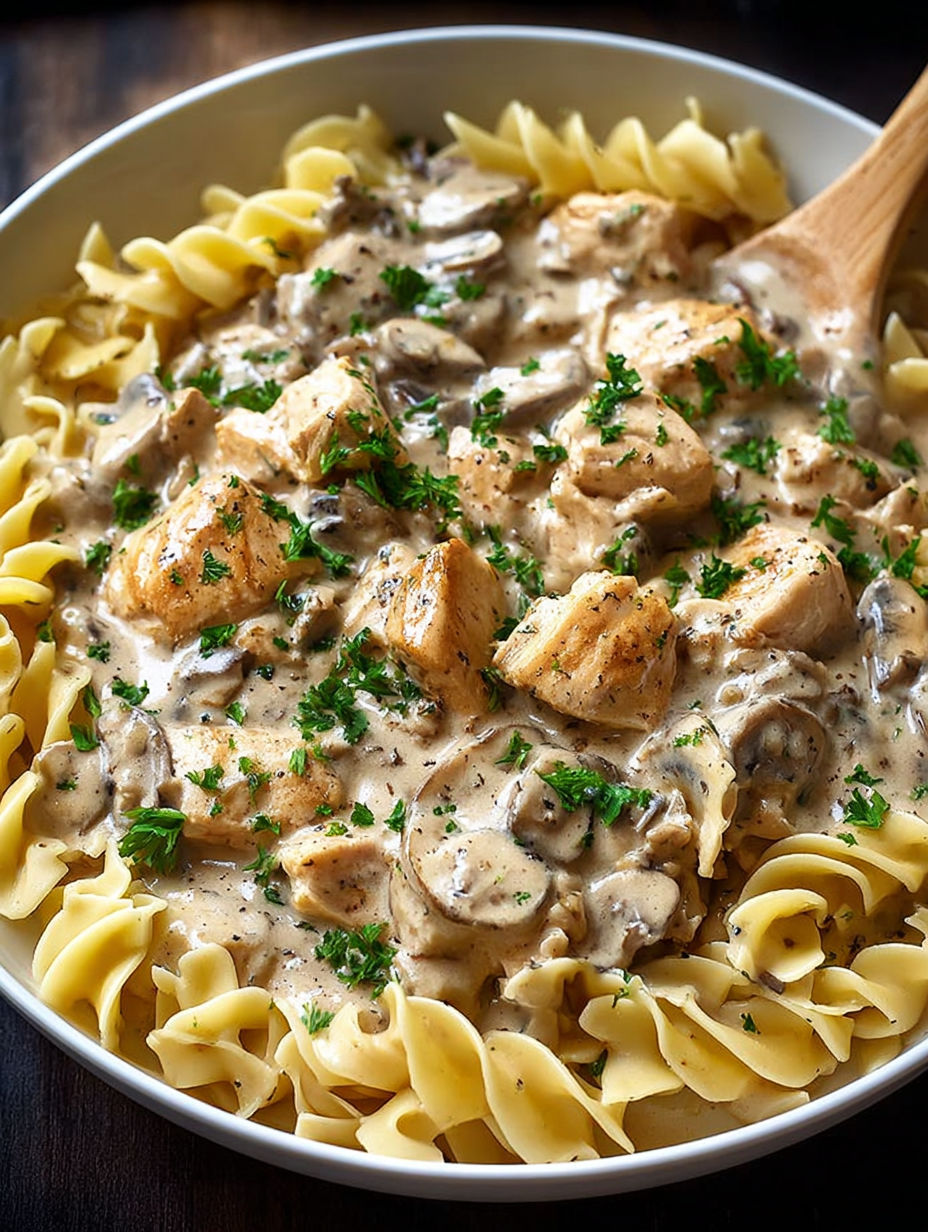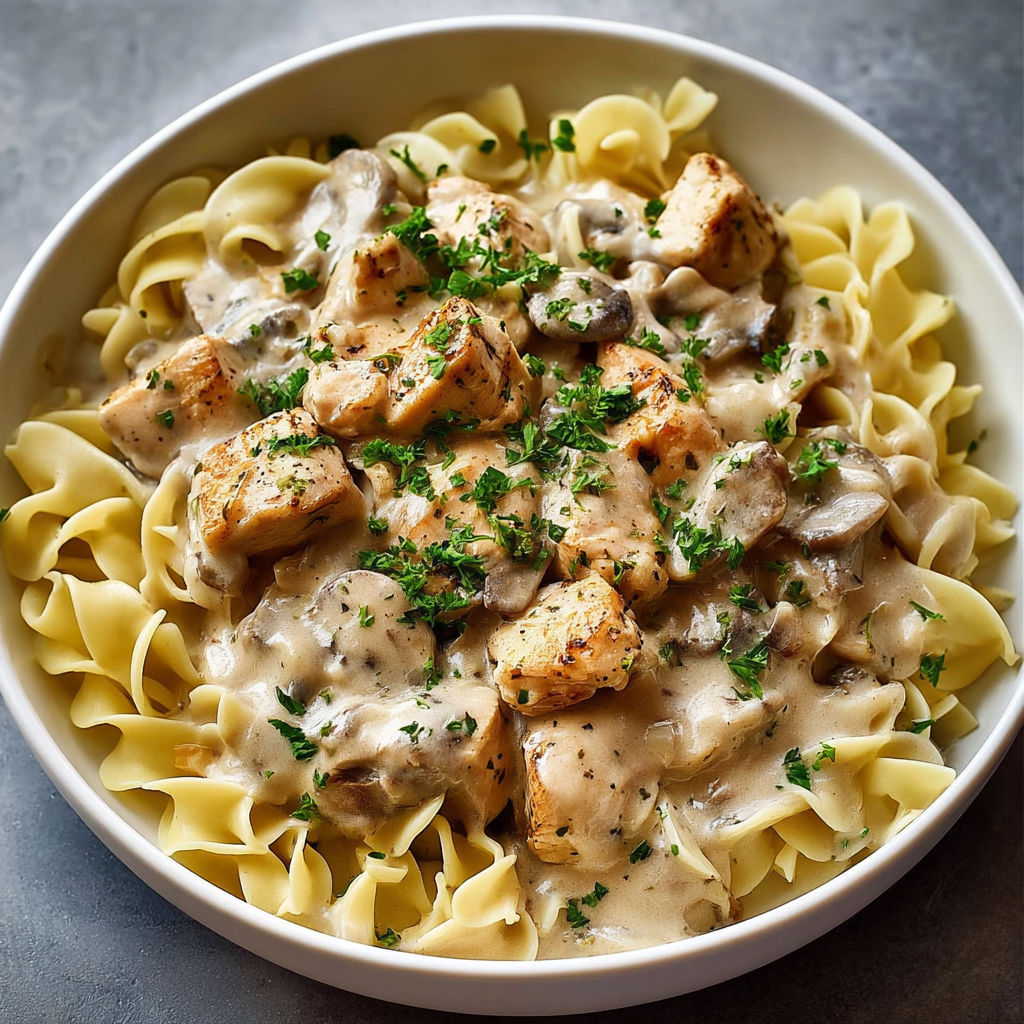 Pin
Pin
This chicken stroganoff transforms simple ingredients into a rich, creamy dinner that's become my go-to comfort meal on busy weeknights. The tender chicken pieces nestled in a velvety sauce will make this an instant family favorite.
I first made this stroganoff during a particularly hectic week when I needed something quick but satisfying. The way my family scraped their plates clean told me this recipe needed to become part of our regular rotation.
Ingredients
Boneless skinless chicken breast provides a lean protein that cooks quickly and absorbs all the delicious flavors of the sauce.
Sweet onion offers a mild sweetness that balances the richness of the dish. Look for Vidalia or Walla Walla varieties when in season.
Garlic cloves add essential aromatic flavor. Choose firm bulbs with tight skin for the freshest taste.
All purpose flour creates the perfect thickness for the sauce. Measure after sifting for best results.
Unsalted chicken stock forms the flavorful base of the sauce. Homemade is wonderful but a good quality store-bought works perfectly.
Heavy cream provides luxurious richness. Opt for full-fat version for the silkiest texture.
Worcestershire sauce adds depth and umami. This ingredient truly makes the dish special.
Sour cream gives that distinctive tang that makes stroganoff unique. Full-fat works best for preventing curdling.
Egg noodles are the traditional pairing. Look for wide egg noodles for maximum sauce-catching capability.
Fresh parsley brightens the finished dish. Italian flat-leaf variety offers the best flavor.
How To Make Chicken Stroganoff
- Brown the chicken
- Melt 2 tablespoons butter in a large skillet over medium heat until it begins to foam slightly. Add chicken pieces in a single layer working in batches if necessary to ensure each piece gets properly browned. The key is not overcrowding the pan which would cause steaming instead of browning. This step takes about 5 minutes per batch. The chicken doesn't need to be fully cooked as it will finish cooking later. Transfer browned chicken to a plate.
- Caramelize the onions
- Add remaining butter to the same pan and add diced onions. Take your time with this step allowing them to cook slowly for 10 to 15 minutes until they become soft and develop a light golden color. Use your spoon to scrape up any browned bits from the chicken which adds incredible flavor to the final sauce.
- Add aromatics and create the roux
- Add minced garlic and cook for just 30 seconds until fragrant but not browned as garlic can become bitter when overcooked. Sprinkle flour evenly over the onion mixture and stir continuously to coat everything well. Cook for a full minute to remove the raw flour taste while continuing to stir to prevent burning.
- Create the sauce
- Pour in chicken stock very slowly while whisking constantly to prevent lumps from forming. This gradual addition is crucial for a smooth sauce. Follow with heavy cream continuing to whisk. The sauce will begin to thicken slightly. Add Worcestershire sauce salt and pepper whisking to incorporate fully.
- Combine and simmer
- Return the browned chicken along with any accumulated juices to the pan stirring gently to coat with sauce. Bring the mixture to a gentle simmer and cook for 5 to 10 minutes until the sauce has thickened to a silky consistency and chicken is completely cooked through. The internal temperature of the chicken should reach 165°F.
- Finish with sour cream
- Remove the pan from heat completely before adding sour cream. This prevents the sour cream from curdling. Stir gently until fully incorporated and the sauce becomes creamy and smooth. Taste and adjust seasonings if needed.
- Serve immediately
- Spoon the stroganoff over cooked egg noodles and garnish with freshly chopped parsley if desired. The contrast of the creamy sauce with the tender noodles creates the perfect comfort food experience.
The secret to this recipe is patience during the onion cooking phase. When I first started making stroganoff I would rush this step but I discovered that those extra minutes of caramelization create a depth of flavor that transforms this dish from good to exceptional. My husband always knows when I've taken my time with the onions because he says the sauce has that special something that makes him reach for seconds.
The History Behind Stroganoff
The original beef stroganoff dates back to 19th century Russia named after Count Pavel Stroganoff a wealthy diplomat. The dish featured tender beef strips in a sour cream sauce. This chicken version emerged as a more economical and quicker alternative to the classic beef version. While purists might insist on beef I find that chicken creates a lighter version that still delivers all the comforting flavors. The combination of creamy sauce with the slight tang from Worcestershire and sour cream remains true to the essence of this beloved dish while making it accessible for everyday cooking.
Make Ahead and Storage Tips
This chicken stroganoff reheats beautifully making it perfect for meal planning. Store leftovers in an airtight container in the refrigerator for up to 3 days. When reheating use gentle heat on the stovetop adding a splash of chicken stock or cream if the sauce has thickened too much. Avoid microwaving if possible as this can cause the sauce to separate. For freezing I recommend storing the stroganoff without the noodles in freezer safe containers for up to 2 months. Thaw overnight in the refrigerator before gently reheating. Fresh noodles take just minutes to cook and will taste much better than frozen ones.

Customization Options
While this recipe is delicious as written there are several ways to make it your own. For a lighter version substitute Greek yogurt for the sour cream and use half and half instead of heavy cream. Add mushrooms to create a more traditional stroganoff feel sautéing them after the onions until golden. For extra flavor consider adding a teaspoon of dijon mustard or a splash of white wine when creating the sauce. You can also swap the chicken for turkey breast or even tofu for a vegetarian version. The versatile sauce works beautifully with many proteins and can be served over rice potatoes or even roasted vegetables instead of egg noodles.

Recipe FAQs
- → Can I substitute the heavy cream in chicken stroganoff?
Yes, you can substitute heavy cream with half-and-half or evaporated milk for a lighter version. The sauce won't be quite as rich but will still be delicious. For a dairy-free option, full-fat coconut milk can work, though it will add a subtle coconut flavor.
- → What can I serve with chicken stroganoff besides egg noodles?
While egg noodles are traditional, chicken stroganoff pairs wonderfully with rice, mashed potatoes, cauliflower rice (for a low-carb option), or crusty bread. You can also serve it with steamed vegetables or a crisp green salad for a complete meal.
- → Can I make chicken stroganoff ahead of time?
Yes, you can make chicken stroganoff ahead of time, but it's best to add the sour cream just before serving when reheating. Store the prepared dish (without sour cream) in an airtight container in the refrigerator for up to 2 days. Reheat gently over low heat to prevent curdling, then stir in fresh sour cream.
- → Why did my sauce curdle in chicken stroganoff?
Curdling usually happens when dairy is added to a very hot mixture or is boiled after adding. To prevent this, make sure to remove the pan from heat before stirring in the sour cream, and never boil the sauce after adding dairy. Using room temperature sour cream can also help prevent curdling.
- → Can I use chicken thighs instead of breast meat?
Absolutely! Boneless, skinless chicken thighs work wonderfully in stroganoff and often result in more tender, flavorful meat. They have a slightly higher fat content which contributes to the richness of the dish. Just cut them into similar-sized pieces and cook them the same way as directed for chicken breast.
- → How do I thicken my stroganoff sauce if it's too thin?
If your sauce is too thin, mix 1 tablespoon of cornstarch with 1 tablespoon of cold water to create a slurry. While the sauce is simmering (before adding sour cream), whisk in the slurry and cook for another minute or two until the desired thickness is reached. Alternatively, you can simmer the sauce longer to reduce and thicken it naturally.
